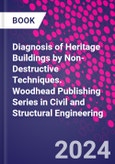Besides their notable historical and cultural significance, heritage buildings crucially contribute to the economy of those countries that rely heavily on the tourism industry. Investigation and monitoring of the origins of deterioration and damage are therefore key to the preservation of architectural heritage.
Diagnosis of Heritage Buildings by Non-Destructive Techniques offers an up-to-date overview of state-of-the-art knowledge by collating specialized studies written by an international group of experts in the field, while also examining the value of these non-intrusive methods through a number of real-life case studies which prove NDT techniques’ global relevance. The volume is an invaluable reference resource for students, researchers, and practitioners alike.
Please Note: This is an On Demand product, delivery may take up to 11 working days after payment has been received.
Table of Contents
Section I: Basic Foundations of Non-Destructive Testing (NDT) Techniques1. A comprehensive overview of NDT: From theoretical principles to implementation
Section II: Infrared Thermography (IRT)
2. Implementation of infrared thermography for built heritage
3. Evaluation of the envelope airtightness by means of combined IRT and pressurization tests in heritage buildings. A case study
4. Integration of historical studies and NDT techniques for the structural characterization of the masonry walls in Palazzo Vecchio, Florence
5. Applications of deep learning to infrared thermography for the automatic classification of thermal pathologies: Review and case study
6. Analyzing Non-Destructive Methods for Building Inspection and Energy Performance: A Focus on photogrammetry and infrared thermography
Section III: Laser Scanning and Photogrammetry
7. Architectural survey of the built heritage using the technique of laser scanning and photogrammetry. Comparison of results in the case study of the Gothic vault: Church of San Vicente in Donostia-San Sebasti�n
8. Intelligent recording of cultural heritage: From point clouds to semantic enriched models
9. Investigating the use of 3D laser scanning to detect damage features in heritage buildings
10. Comparison of results obtained by photogrammetry tools vs LED handheld scanning technique in architectural heritage. Application to plasterwork located in a world heritage site
11. Exploring the accessibility of deformed digital heritage models
12. Sensor integration for built heritage diagnostics: From aerial and terrestrial photogrammetry to SLAM technologies
Section IV: Heritage Building Information Modelling (BIM) & Digital Twins (DTs)
13. From a multidisciplinary analysis to HBIM: Digital tools for the digital documentation of historical buildings
14. Automating as-built heritage inspection using unmanned aerial systems: A defect management framework based on Heritage Building Information Modelling (HBIM)
15. From 3D models to Historic BIM and Digital Twins: A review
Section V: Other techniques for heritage building diagnosis
16. Monitoring of heritage buildings and dynamic simulation models
17. Understanding the invisible: Interpretation of results in ultrasonic tomography of gothic masonry using metrology and geometry
18. Advances and comparative study of artificial vision techniques applied to non-destructive tests in heritage buildings
19. NDT for the study of decorative revetments: Implementation of spectroscopic techniques
20. Evaluation of heritage stone deterioration through non-destructive techniques (ultrasonic pulse velocity, rebound hammer test, SEM, and XRD)
21. Evaluation of the mechanical characteristics of marble using non-destructive techniques (NDT): ultrasound vs Schmidt hammer rebound tests
22. Applications of the GPR technique to heritage buildings: Case studies and combination with other NDTs
Authors
Blanca Tejedor Herr�n Assistant Professor, Department of Project and Construction Engineering, Universitat Polit�cnica de Catalunya, Barcelona, Spain.Blanca Tejedor Herr�n is Industrial Engineer and works as an Assistant Professor in the Department of Project and Construction Engineering in the Polytechnic University of Catalonia. Her expertise focuses on the application of infrared thermography for building diagnosis, indoor thermal comfort modelling and smart facility management. She is author of more than 20 scientific papers and she obtained several awards of the research field.
David Bienvenido-Huertas Assistant Professor, Department of Building Construction, University of Granada, Granada, Spain.David Bienvenido-Huertas is Assistant Professor in the Department of Building Construction at the University of Granada. He is Visiting Professor at the University of La Coru�a. His area of expertise covers climate change in the building sector, heat transfer, building simulation and indoor environment. He is author of more than 80 research papers and he is recognized reviewer of various international indexed journals








